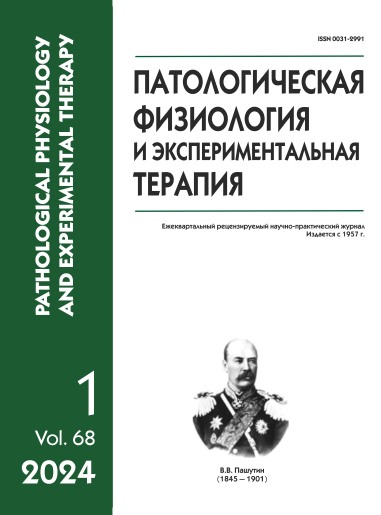The effect of fetoplacental insufficiency in pregnant women with intrauterine infection on the health of newborns and young children
Abstract
The aim of the work is to study the role of cortisol and IL–10 in the mechanism of formation of fetoplacental insufficiency against the background of intrauterine infection, to assess the condition of newborns and the incidence of children under three years of age.
The methodology. A morphological and histological examination of the afterbirth was performed in 205 pregnant women of a high infectious risk group. The presence of signs of ascending, hematogenous and mixed infection of the afterbirth, as well as signs of acute and chronic placental insufficiency, were evaluated. In the first and second trimesters of pregnancy, the concentration of cortisol, as well as IL-6 and IL-10, was determined in the blood serum of women by enzyme immunoassay. The condition of the newborn was assessed on the Apgar scale. Outpatient records of children under three years old were analyzed. The analysis of the obtained data was carried out using nonparametric statistical methods.
Results. In the groups with ascending and mixed infection, cortisol levels in the 1st trimester of pregnancy were statistically significantly higher relative to the control group (p <0.05). Low cortisol levels in the same groups persisted in the second trimester of pregnancy.
The concentration of IL-10 in groups with ascending and hematogenous infection at 11-12 weeks of pregnancy was statistically significantly reduced. An inverse correlation was found between cortisol levels and IL-10 levels in ascending and hematogenous infections. In women with signs of infection of the afterbirth, immature intermediate villi were more common, which indicates a violation of the maturation of the placenta. With ascending infection of the afterbirth, chronic compensated insufficiency developed statistically significantly more often, and with mixed infection - in the subcompensation stage.
Fetal hypotrophy was statistically significantly more common in hematogenous infection. The incidence rate in the groups with different infection routes was statistically significantly higher compared to the control.
Conclusion. The data obtained indicate a violation of the formation of the fetoplacental complex in ascending, hematogenic and mixed infection pathways, due to activation of cortisol production and a decrease in IL-10 concentration at the beginning of gestation.The formation of early fetolplacental insufficiency against the background of intrauterine infection increases the risk factor for the morbidity of newborns and children. Children of a high infectious risk group require careful monitoring of their health status.
Downloads
References
2. Vuppaladhadiam L, Lager J, Fiehn O, Weiss S, Chesney M, Hasdemir B, Bhargava A. Human Placenta Buffers the Fetus from Adverse Effects of Perceived Maternal Stress. Cells. 2021;10(2):379.
3. Burton GJ, Fowden AL, Thornburg KL. Placental Origins of Chronic Disease. Physiol Rev. 2016.;96(4):1509-65.
4. Jane K. Cleal, Rohan M. Lewis,ane K. Cleal, Rohan M. Lewis. The Placenta and Developmental Origins of Health and Disease. The Epigenome and Developmental Origins of Health and Disease. Academic Press. 2016; 439-461.
5. Behura SK, Dhakal P, Kelleher AM, Balboula A, Patterson A, Spencer TE. The brain-placental axis: Therapeutic and pharmacological relevancy to pregnancy. Pharmacol Res. 2019; 149:104468.
6. Myatt L, Thornburg KL. Effects of Prenatal Nutrition and the Role of the Placenta in Health and Disease. Methods Mol Biol. 2018; 1735:19-46.
7. Aplin, J.D., Myers, J.E., Timms, K. et al. Tracking placental development in health and disease. Nat Rev Endocrinol 16, 479–494 (2020).
8. Mor G, Cardenas I. The immune system in pregnancy: a unique complexity. Am J Reprod Immunol. 2010;63(6):425-33.
9. Kumar M, Saadaoui M and Al Khodor S Infections and Pregnancy: Effects on Maternal and Child Health. Front. Cell. Infect. Microbiol. 2022; 12:873253.






